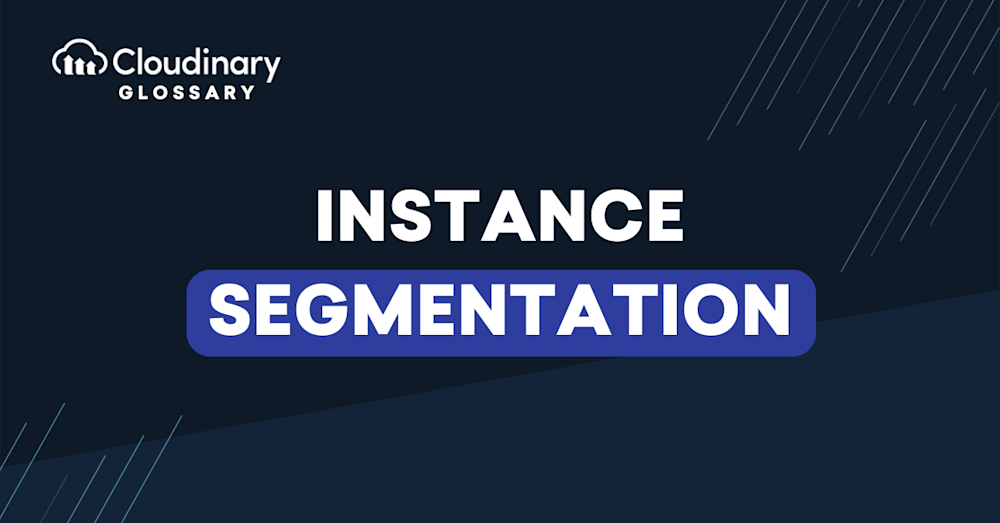What Is Instance Segmentation?
Instance segmentation is a computer vision technique that detects and delineates individual objects within an image and assigns them to their respective categories. Compared to semantic segmentation, which groups all pixels belonging to a specific category, instance segmentation further separates distinct objects within the same class. This enables a more detailed understanding of the image, as objects can be distinctly recognized and counted, regardless of their overlapping or close proximity.
Instance Segmentation vs. Other Types of Image Segmentations
Comparing instance segmentation with other image segmentation forms can provide a clearer understanding of its unique qualities. Broadly, image segmentation is divided into three main types: semantic segmentation, object detection, and instance segmentation.
Semantic segmentation, the simplest type, classifies each pixel in an image into categories based on its class but merges the pixels of multiple objects of the same class into a single entity. On the other hand, object detection identifies pixel classes and encapsulates each distinct object within a bounding box, pinpointing objects’ locations. Yet, it does not distinguish between multiple objects of the same class.
Instance segmentation combines the best of both worlds. It provides object detection’s granular identification with bounding boxes and further enhances this detail level using semantic segmentation’s pixel-wise classification. This approach makes individual objects distinctly isolated and classified, even if they belong to the same class and are overlapping or intertwined.
Where Is Instance Segmentation Used?
Instance segmentation has numerous applications across various domains, including:
- Autonomous driving: Instance segmentation is used to detect and track pedestrians, vehicles, and traffic signs for autonomous cars.
- Medical imaging: Instance segmentation can be used to segment organs or tumors in medical images, aiding diagnosis and treatment planning.
- Retail and e-commerce: Instance segmentation can be applied to product images for object detection and recognition, enabling automated inventory management and accurate product recommendations.
- Security and surveillance: Instance segmentation is used to identify and track individuals or objects of interest in security and surveillance footage.
The Benefits of Instance Segmentation
Instance segmentation not only allows for more precise object recognition and tracking but it also introduces a multitude of additional benefits to further elevate the capabilities of computer vision systems, such as:
- Greater precision – Instance segmentation isolates each object in an image, resulting in fine-grained object identification. This individual distinction allows for improved accuracy and offers a deeper level of image analysis.
- Improved efficiency – By leveraging advanced machine learning techniques, instance segmentation streamlines the process of identifying and categorizing individual instances of objects, thereby augmenting operational efficiency.
- Enhanced object tracking – Owing to its ability to differentiate between individual objects in overlapping or close proximity situations, instance segmentation enhances tracking applications like video surveillance and real-time monitoring.
- Robustness in complex scenes – Instance segmentation excels in handling crowded images with intricate object interactions, which is particularly handy in areas like traffic monitoring and crowd analysis.
- Facilitation of 3D reconstruction – By providing detailed boundaries and categories for each object instance, instance segmentation aids in creating more accurate 3D models for augmented and virtual reality applications.
- Improved object interaction understanding – Given its knack for distinct identification, instance segmentation can help understand object interactions and context within a scene, which benefits fields like robotics and autonomous vehicles.
Wrapping Up
To sum up, instance segmentation provides a powerful framework for effective and detailed image object identification. Its ability to accurately separate and recognize individual instances of objects, even within complex and crowded scenes, sets it apart from other image segmentation types. This unique capability enables a wealth of real-world applications, from improving object tracking in surveillance systems to enhancing our understanding of object interactions in autonomous vehicles and robotics.
Cloudinary offers a suite of visual tools and APIs that can help you harness and leverage the power of such advanced computer vision technologies, including instance segmentation. Whether you’re a seasoned developer or just entering the field, Cloudinary provides the tools to ease the implementation and execution of these complex processes.
Take the leap and start exploring the potential of instance segmentation with Cloudinary today, and see how it can revolutionize your work.




